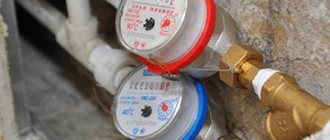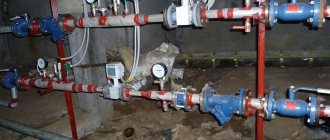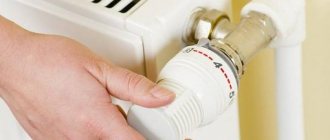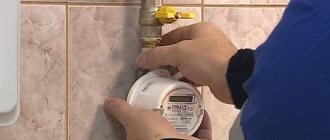Installing a heating meter in your apartment is the best solution for saving your family budget. The installation of the device is carried out in accordance with a certain technology, so the work must be carried out by specialized organizations.
To obtain benefits, it is necessary to focus on the adopted regulations, on the basis of which the flow meter is recognized as being put into operation, and the readings of the device are accepted for calculating the monthly payment.
Why do you need a heating meter?
Probably everyone has encountered problems with central heating batteries. Modern houses are designed with autonomous heating, so that the consumption is calculated for each apartment separately. People who live in older houses do not have such a prerogative. Sometimes they have to suffer because utility services want to save money and turn up the heating, as a result, the temperature in the house drops, and the bills come in sky high, the question arises: what are we paying for then?
Let's consider the main problems of centralized heating:
- The used cubic meters of heat are distributed to all apartments, taking into account data on the area of the apartment from those. passports, but redesigned, enlarged apartments are not taken into account. So you may end up paying more for luckier neighbors.
- Significantly less heat enters the batteries than comes out of the boiler room. In fact, the cost of heating includes heat that does not even enter your apartment.
- The plumbers turn up the heating, you freeze or use additional heating methods (for which you also pay), and the bills come the same.
Important! Considering the listed disadvantages of central heating, one can understand why so many people want to install individual meters. About 30% of the heat we pay for does not reach the apartment.
By installing the device in an apartment, we can check how much heat is supplied and pay only for it. If you don't have enough heating power, you will at least pay an adequate price.
Is it beneficial to have it in the MKD?
Apartment heat meters allow you to control heating fees.
The temperature in the apartment can be adjusted independently. Before leaving home, residents can lower the temperature in the apartment or completely turn off the heating during their departure, and at the end of the month they can feel the savings. According to experts, apartment meters can save you up to 2 rubles per month. True, savings depend on the quality of home insulation. On average, installing a meter and the cost of the device itself will cost about 20,000 rubles.
If the house has good insulation, the IPU will pay for itself in about a year. If the apartment has large rooms and they are heated independently of each other, the apartment meter will be unprofitable. In addition, you need to take into account the heating system in the house. The devices are usually mounted directly on the coolant supply pipe; if the heating system is standing, you will have to install a separate meter on each pipe, which is quite expensive. With a horizontal system, one meter is installed.
Is it possible to install a heat meter in an apartment?
The question: is it allowed to install heat meters in an apartment still remains relevant.
The World Wide Web gives diametrically opposed answers. Perhaps the utility services themselves are misleading people, since they do not really benefit from such modernization. However, we cannot be fooled so easily; after reviewing the legislation, we made an unambiguous conclusion: it is possible to establish, but there are several nuances.
Please note that installing a heat meter in an apartment yourself is not only prohibited, but also very dangerous. Outside interference in the heating system can result in an accident, and if everything goes smoothly, then, in any case, it will not be accepted by the heating service.
If you decide to install such a meter, then you need to do everything according to the rules.
When installation is not possible
There is no legislation prohibiting the installation of your own meter, but there are cases when technically installing it simply does not make sense. This situation is possible in very old houses, where changing the heating system is impossible or not profitable.
Basically, the problem lies in the wiring of the heating system. It comes in two types:
- Vertical system. Heat passes through all floors up and then back. In this case, there are usually several risers per apartment, and a meter will have to be installed on each of them, which is very expensive. Most often, such heating is installed in Khrushchev-era buildings.
- Horizontal - has two pipes, heat enters through one, and through the other it goes out with one riser to the apartment. Therefore, installing a meter will not be a problem.
To be absolutely sure whether a heat meter can be installed in an apartment, contact a specialist. They will conduct an inspection and tell you how effective the modernization will be and how much it will cost to maintain this system.
Heat meters in the legislation of the Russian Federation
It is important to note that in the Russian Federation there is a law that obliges the installation of heat meters in an apartment building at the expense of the residents. If this is not done, then you will have to pay a tariff with a coefficient of 1.5, if not more.
In this case, it does not matter whether you have an individual meter for your apartment; its readings will not be taken into account. Therefore, first make sure that your house has a common meter, and then install an individual one according to the procedure established by law.
The process of approving standards and tariffs
All calculated indicators are compiled by specialists and employees of heat supply organizations. Then they are necessarily approved by energy commissions operating within a particular locality, region, or territory.
Representatives of local authorities and public organizations, as well as deputies of various levels are also invited to the meeting where planned prices for heat energy are considered.
Tariffs are calculated in accordance with the legislative acts of the Government of the Russian Federation, which establish consumption standards for housing and communal services, including the amount of heat energy. Heat supply organizations must document and justify the proposed prices for heating services.
Since the actual outside air temperature during the heating season may not coincide with the calculated standards, housing and communal services perform recalculation once a year.
In severe cold weather, consumers will have to pay an additional amount, while in mild winters, an overpayment is possible, which is counted toward future payments. The same procedure is carried out once a year in houses where flow meters are not provided.
The procedure for legal installation of a heat meter
The legislation does not prescribe mandatory standards for heating meters per apartment. But the law specifies the procedure that must be followed to install a heat meter:
- Write a statement to the organization that supplies heat to your home. Specialists will check the possibility of carrying out this procedure from a technical point of view. After checking, if everything is fine, then you will receive technical support. conditions that specify the nuances of developing and installing a meter in your apartment.
- If you have created a condominium association, then its chairman needs to provide a copy of the application and clarify the process of installing the heat meter.
- Find an organization that develops projects for installing heat meters, check that they have all the documents confirming their qualifications in this matter.
- Approve the project from the company that supplies heat, then contact the company that installs heat meters.
- The installed equipment must be shown to the heat supply company and an agreement must be signed with them. A specialist from this company will service the heat meter, but at your expense. From now on, you will pay for the actual heat you use.
For reference: the meter will count the heat consumption only for your apartment, but you will be required to pay part of the amount for heating the non-residential premises of the house, along with other residents.
Types of heat meters for heating
If you have already decided to install a heating meter in your apartment and have checked all the technical capabilities of the house, then it’s time to think about which device to buy. Heat meters come in several types; they differ in price, quality, durability and temperature measurement method, but functionally they perform the same role.
Mechanical heat meters
Let's start with the simplest and most budget option - a mechanical heat meter. This option is the cheapest, but also the most short-lived. It does not tolerate dirt, temperature changes, or rust well, so in just a couple of years you will have to buy a new one. The design of a mechanical meter is very simple: a gear rotates inside and moves numbers that show how much heat your apartment consumes. The system is almost identical to the light meter.
Ultrasonic meters
They more accurately measure the amount of heat received. Such a device will last a very long time if you install a special filter so that only water purified from debris passes through the meter. Its price is higher than that of a mechanical counter. Although if you calculate how much budget money you will save on purchasing and repairing a device, the issue is moot. Heat suppliers often insist on choosing just such a meter, because its measurements cannot be influenced from the outside.
Vortex heat meters
This type of heat meter calculates the wasted heat using obstacles that are created during water circulation (vortexes). This universal device is suitable for horizontal and vertical heating systems and shows accurate data despite various deposits in the pipes. When choosing a vortex heat meter, you need to take into account the size of the pipe to which the device will be attached.
Electromagnetic meters
When water moves through the pipes and delivers heat to our apartment, a certain amount of current is generated, which is read by the electromagnetic meter. Electromagnetic meters are cheaper, so they are very popular. This is a kind of improved version of a mechanical meter.
Poor quality water, as well as improper installation of the device, can lead to rapid breakdown of the device. This option is used both for the whole house and as an individual meter for an apartment.
General recommendations for choosing a device and its installation
We have already looked at the main types of heating meters, but which one is better to buy? In this matter, you can consult with experts who will prepare a project for installing a heating meter in an apartment. They will know what problems the device will encounter, and which one will work better under given conditions.
Also, the choice will depend on your financial capabilities. However, it is better to buy a durable ultrasonic device, although it is more expensive than one that will have to be replaced in a couple of years.
To install a heating meter in an apartment, you should contact a certified company. Experts do not recommend performing this procedure yourself - then problems will arise with the device being put into operation. Depending on the type and model of the device you buy, the installation procedure will differ; the easiest way to install an electromagnetic meter.
Important: after installing the meter, do not forget to register it with the heat energy supplier, otherwise it will be considered not working.
Verification and readings
All measuring instruments require regular verification - this way the serviceability of the meter is verified and, accordingly, the correctness of the resident’s transmission of consumption readings.
Primary verification is carried out at the manufacturer. This is evidenced by a sticker or stamp on the heat meter itself and an entry in the accompanying documents.
In the future, verification must be performed every four years at the expense of the apartment owner. To do this, you need to contact:
- to a company licensed to provide such services;
- to the service center of the meter manufacturer;
- to the local branch of Rostest.
Readings are taken in the same way as from other meters - electric, water. The difference between the readings for the current and last month is the actual expense, which must be multiplied by the tariff rate to calculate the amount payable.
The meter can determine consumption in kilowatts, but must transmit readings in gigacalories. To convert watts to calories, the removed figure is multiplied by 0.0008598.











